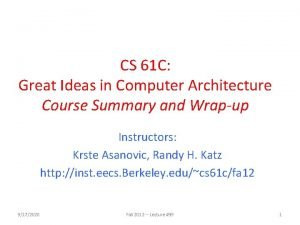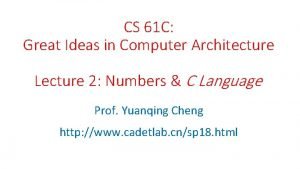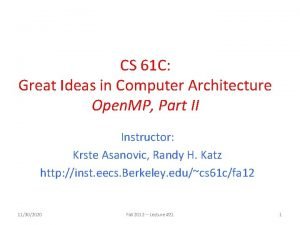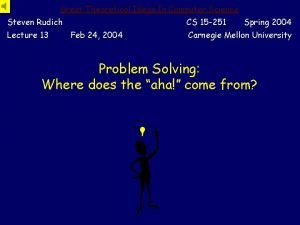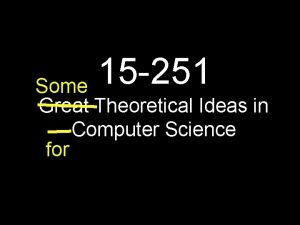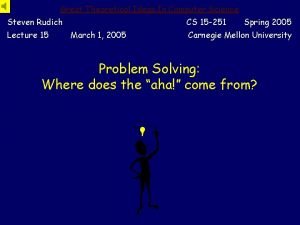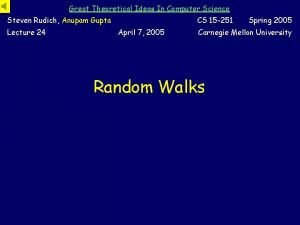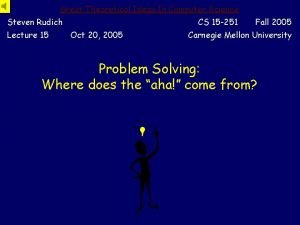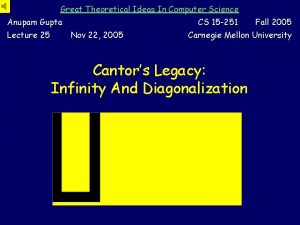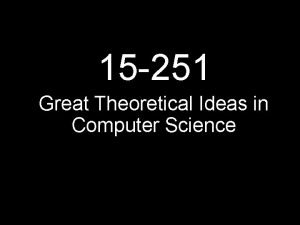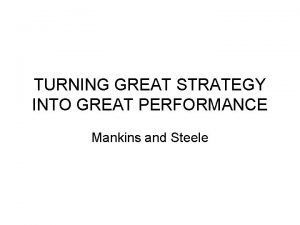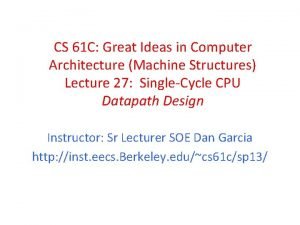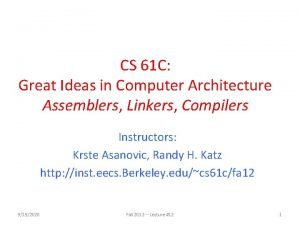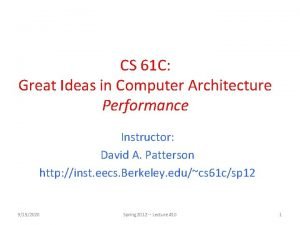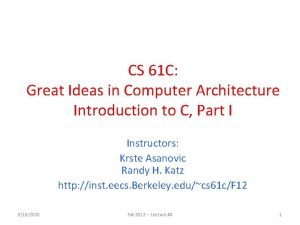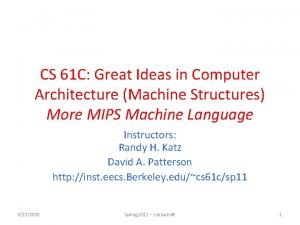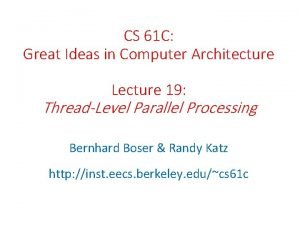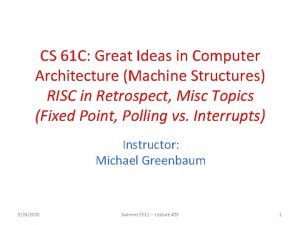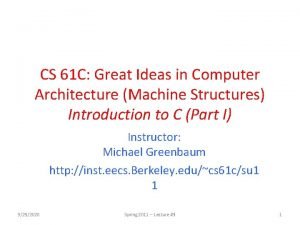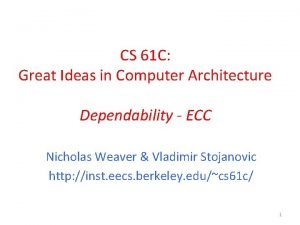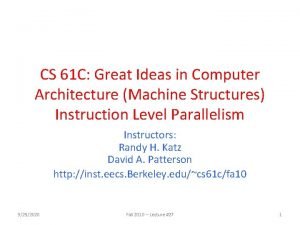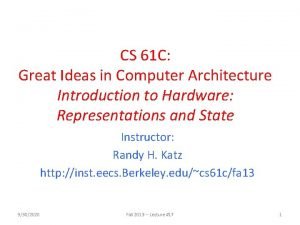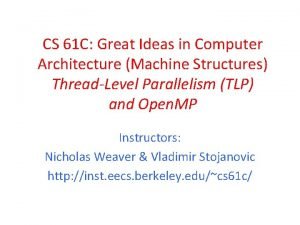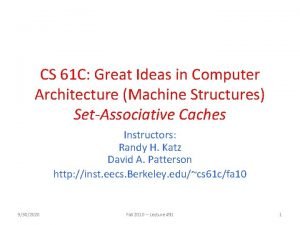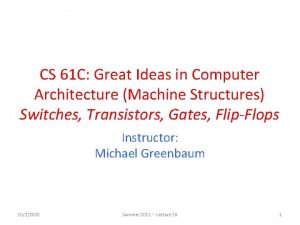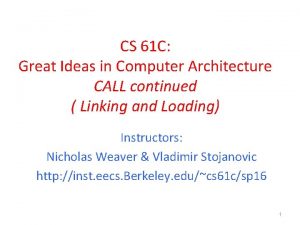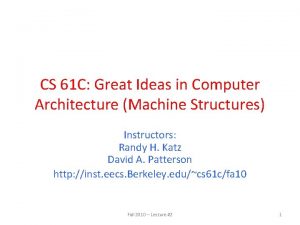CS 61 C Great Ideas in Computer Architecture


































- Slides: 34

CS 61 C: Great Ideas in Computer Architecture (Machine Structures) Instruction Level Parallelism Instructors: Randy H. Katz David A. Patterson http: //inst. eecs. Berkeley. edu/~cs 61 c/fa 10 9/25/2020 Fall 2010 -- Lecture #30 1

Review • Pipeline challenge is hazards – Forwarding helps w/many data hazards – Delayed branch helps with control hazard in 5 stage pipeline – Load delay slot / interlock necessary • More aggressive performance: – Longer pipelines (10 to 15 stages) – Superscalar (2 to 4 instructions at a time) – Out-of-order execution (go past the stall) – Speculation (branch prediction, speculative execution) 9/25/2020 Fall 2010 -- Lecture #30 2

Agenda • • Review Dynamic Scheduling Example AMD Barcelona Administrivia Big Picture: Types of Parallelism Peer Instruction Summary 9/25/2020 Fall 2010 -- Lecture #30 3

Dynamic Pipeline Scheduling • Allow the CPU to execute instructions out of order to avoid stalls – But commit result to registers in order • Example lw $t 0, 20($s 2) addu $t 1, $t 0, $t 2 subu $s 4, $t 3 slti $t 5, $s 4, 20 – Can start subu while addu is waiting for lw Fall 2010 -- Lecture #30 9/25/2020 4

Speculation • “Guess” what to do with an instruction – Start operation as soon as possible – Check whether guess was right • If so, complete the operation • If not, roll-back and do the right thing • Common to static and dynamic multiple issue • Examples – Speculate on branch outcome (Branch Prediction) • Roll back if path taken is different – Speculate on load • Roll back if location is updated Fall 2010 -- Lecture #30 9/25/2020 5

Pipeline Hazard: Matching socks in later load 6 PM 7 T a s k 8 9 10 3030 30 30 A 11 12 1 2 AM Time bubble B C O D r d E e r F • A depends on D; stall since folder tied up; 9/25/2020 Fall 2010 -- Lecture #30 6

Out-of-Order Laundry: Don’t Wait 6 PM 7 T a s k 8 9 10 3030 30 30 A 11 12 1 2 AM Time bubble B C O D r d E e r F • A depends on D; rest continue; need more resources to allow out-of-order 9/25/2020 Fall 2010 -- Lecture #30 7

Out-of-Order Execution (1/2) • Basically, unroll loops in hardware 1. Fetch instructions in program order (≤ 4/clock) 2. Predict branches as taken/untaken 3. To avoid hazards on registers, rename registers using a set of internal registers (~80 registers) 4. Collection of renamed instructions might execute in a window (~60 instructions) 5. Execute instructions with ready operands in 1 of several functional units (ALUs, FPUs, Ld/St) 9/25/2020 Fall 2010 -- Lecture #30 8

Out-of-Order Execution (2/2) 6. Buffer results of executed instructions until predicted branches are resolved in reorder buffer 7. If predicted branch correctly, commit results in program order 8. If predicted branch incorrectly, discard all dependent results and start with correct PC 9/25/2020 Fall 2010 -- Lecture #30 9

Dynamically Scheduled CPU Preserves dependencies Hold pending operands Results also sent to any waiting reservation stations Reorders buffer for register writes Fall 2010 -- Lecture #30 9/25/2020 Can supply operands for issued instructions 10

Out Of Order Intel • All use OOO since 2001 Microprocessor Year Clock Rate Pipeline Stages Issue width Out-of-order/ Speculation Cores Power i 486 1989 25 MHz 5 1 No 1 5 W Pentium 1993 66 MHz 5 2 No 1 10 W Pentium Pro 1997 200 MHz 10 3 Yes 1 29 W P 4 Willamette 2001 2000 MHz 22 3 Yes 1 75 W P 4 Prescott 2004 3600 MHz 31 3 Yes 1 103 W Core 2006 2930 MHz 14 4 Yes 2 75 W Core 2 Yorkfield 2008 2930 MHz 16 4 Yes 4 95 W Core i 7 Gulftown 2010 3460 MHz 16 4 Yes 6 130 W Fall 2010 -- Lecture #30 9/25/2020 11

§ 4. 11 Real Stuff: The AMD Opteron X 4 (Barcelona) Pipeline AMD Opteron X 4 Microarchitecture 72 physical registers Fall 2010 -- Lecture #30 9/25/2020 12

AMD Opteron X 4 Pipeline Flow • For integer operations n n n 12 stages (Floating Point is 17 stages) Up to 106 RISC-ops in progress Intel Nehalem is 16 stages for integer operations, details not revealed, but likely similar to above n Intel calls RISC operations “Micro operations” or “μops” Fall 2010 -- Lecture #30 9/25/2020 13

Does Multiple Issue Work? The BIG Picture • Yes, but not as much as we’d like • Programs have real dependencies that limit ILP • Some dependencies are hard to eliminate – e. g. , pointer aliasing • Some parallelism is hard to expose – Limited window size during instruction issue • Memory delays and limited bandwidth – Hard to keep pipelines full • Speculation can help if done well Fall 2010 -- Lecture #30 9/25/2020 14

Administrivia • As of today, made 1 pass over all Big Ideas in Computer Architecture • Following lectures go into more depth on topics you’ve already seen while you work on projects – 2 lectures in more depth on Caches – 1 in more depth on C storage management – 1 on Protection, Traps – 2 on Virtual Memory, TLB, Virtual Machines – 1 on Economics of Cloud Computing – 1. 5 on Anatomy of a Modern Microprocessor (Sandy Bridge, latest microarchitecture from Intel) 9/25/2020 Fall 2010 -- Lecture #30 15

Administrivia • Project 3: TLP+DLP+Cache Opt (Due 11/13) • Project 4: Single Cycle Processor in Logicsim – Due Part 2 due Saturday 11/27 – Face-to-Face : Signup for 15 m time slot 11/30, 12/2 • Extra Credit: Fastest Project 3 (due 11/29) • Final Review: Mon Dec 6, 3 hrs, afternoon (TBD) • Final: Mon Dec 13 8 AM-11 AM (TBD) – Like midterm: T/F, M/C, short answers – Whole Course: readings, lectures, projects, labs, hmwks – Emphasize 2 nd half of 61 C + midterm mistakes 9/25/2020 Fall 2010 -- Lecture #30 16

Administrivia • What classes should I take (now)? • Take classes from great teachers! (teacher > class) – Distinguished Teaching Award (very hard to get) • http: //teaching. berkeley. edu/dta-dept. html – HKN Course evaluations (≥ 6 is very good) • http: //hkn. eecs. berkeley. edu/student/Course. Survey/ – EECS web site has plan for year (up in late spring) • http: //www. eecs. berkeley. edu/Scheduling/CS/schedule-draft. html • If have choice of multiple great teachers – – – 9/25/2020 CS 152 Computer Architecture and Engineering CS 162 Operating Systems and Systems Programming CS 169 Software Engineering (for Saa. S with Fox) CS 194 Engineering Parallel Software CS 267 Applications of Parallel Computers Fall 2010 -- Lecture #30 17

Big Picture on Parallelism • 2 types of parallelism in applications 1. Data-Level Parallelism (DLP): arises because there are many data items that can be operated on at the same time 2. Task-Level Parallelism (TLP): arises because tasks of work are created that can operate largely in parallel 9/25/2020 Fall 2010 -- Lecture #30 18

Big Picture on Parallelism • Hardware can exploit app Data LP and Task LP in 4 ways 1. Instruction Level Parallelism: Hardware exploits application DLP using ideas like pipelining and speculative execution 2. SIMD architectures exploit app DLP by applying a single instruction to a collection of data in parallel 3. Thread-Level Parallelism exploits either app DLP or TLP in a tightly-coupled hardware model that allows for interaction among parallel threads 4. Request-Level Parallelism exploits parallelism among largely decoupled tasks and is specified by the programmer of the operating system 9/25/2020 Fall 2010 -- Lecture #30 19

Machine Structures: Lecture 1 Application (ex: browser) Compiler Software Hardware Assembler Processor Operating System (Mac OSX) Memory I/O system CS 61 C Instruction Set Architecture Datapath & Control Digital Design Circuit Design transistors 9/25/2020 Fall 2010 -- Lecture #30 20

Peer Instruction Instr LP, SIMD, Thread LP, Request LP are examples of • Parallelism above the Instruction Set Architecture • Parallelism explicitly at the level of the ISA • Parallelism below the level of the ISA Inst. LP SIMD A) (red) B) (orange) C) (green) D) (yellow) E) (pink) F) (blue) 9/25/2020 = ∨ = ∧ = = ∧ Fall 2010 ∧ -- Lecture #30 Thr. LP Req. LP = = ∧ ∧ ∧ ∧ ∧ 21

Peer Instruction Instr LP, SIMD, Thread LP, Request LP are examples of • Parallelism above the Instruction Set Architecture • Parallelism explicitly at the level of the ISA • Parallelism below the level of the ISA A) B) C) D) (yellow) E) F) 9/25/2020 ILP SIMD TLP RLP = ∨ = ∧ = = ∧ Fall 2010 ∧ -- Lecture #30 = = ∧ ∧ ∧ ∧ ∧ 22

Peer Instruction: Stall, Forward, OK? For each code sequence, chose whether I. It must stall II. It can avoid stalls using only forwarding III. It can execute without stalling or forwarding 1: 2: 3: addi $t 1, $t 0, #1 lw $t 0, 0($t 0) add $t 1, $t 0 addi $t 2, $t 0, #2 add $t 1, $t 0 addi $t 2, $t 0, #5 addi $t 3, $t 0, #2 addi $t 4, $t 1, #5 addi $t 3, $t 0, #4 addi $t 5, $t 1, #5 A) All I (stall) E) 1 I, 2 II, 3 II B) 1 I, 2 I, 3 II F) 1 II, 2 II, 3 III C) 1 I, 2 I, 3 III G) All II (must forward) D) 1 I, 2 II, 3 III H) All III (no stall, no fwd) 9/25/2020 Fall 2010 -- Lecture #30 23

Sequence 1 Time (clock cycles) Reg D$ Reg I$ Reg ALU I$ D$ ALU Reg ALU I$ ALU I n s lw t add r. instr O instr r d instr e r D$ Reg

Sequence 2 Time (clock cycles) Reg D$ Reg I$ Reg ALU I$ D$ ALU Reg ALU I$ ALU I n s add t addi r. addi O instr r d instr e r D$ Reg

Sequence 3 Time (clock cycles) Reg D$ Reg I$ Reg ALU I$ D$ ALU Reg ALU I$ ALU I n s addi t addi r. addi O addi r d addi e r D$ Reg

Peer Instruction: Stall, Forward, OK? For each code sequence, chose whether I. It must stall II. It can avoid stalls using only forwarding III. It can execute without stalling or forwarding 1: 2: 3: addi $t 1, $t 0, #1 lw $t 0, 0($t 0) add $t 1, $t 0 addi $t 2, $t 0, #2 add $t 1, $t 0 addi $t 2, $t 0, #5 addi $t 3, $t 0, #2 addi $t 4, $t 1, #5 addi $t 3, $t 0, #4 addi $t 5, $t 1, #5 A) All I (stall) E) 1 I, 2 II, 3 II B) 1 I, 2 I, 3 II F) 1 II, 2 II, 3 III C) 1 I, 2 I, 3 III G) All II (must forward) D) 1 I, 2, II, 3 III H) All III (no stall, no fwd) 9/25/2020 Fall 2010 -- Lecture #30 27

Peer Instruction Not all instructions are active in every stage of the 5 -stage pipeline. Ignoring the effects of hazards, which of the following are true? 1. Allowing jumps, branches, and ALU instructions to take fewer stages than the 5 required by the load instruction will increase pipeline performance for most programs. 2. Trying to allow some instructions to take fewer cycles does not help, since throughput is determined by the clock cycle; the number of pipe stages per instruction affects latency, not throughput. 3. You cannot make ALU instructions take fewer cycles because of the write back of the result, but branches and jumps can take fewer cycles, so there is some opportunity for improvement. 4. Instead of trying to make instructions take fewer cycles, we should explore making the pipeline longer, so that instructions take more cycles, but the cycles are shorter. This could improve performance. A) All false B) 1 F, 2 F, 3 F, 4 T C) 1 F, 2 F, 3 T, 4 F 9/25/2020 D) 1 F, 2 T, 3 F, 4 F E) 1 T, 2 F, 3 F, 4 F F) 1 F, 2 T, 3 F, 4 T G) 1 F, 2 T, 3 T, 4 T Fall 2010 -- Lecture #30 H) All true 28

Peer Instruction Not all instructions are active in every stage of the 5 -stage pipeline. Ignoring the effects of hazards, which of the following are true? 1. Allowing jumps, branches, and ALU instructions to take fewer stages than the 5 required by the load instruction will increase pipeline performance for most programs. 2. Trying to allow some instructions to take fewer cycles does not help, since throughput is determined by the clock cycle; the number of pipe stages per instruction affects latency, not throughput. 3. You cannot make ALU instructions take fewer cycles because of the write back of the result, but branches and jumps can take fewer cycles, so there is some opportunity for improvement. 4. Instead of trying to make instructions take fewer cycles, we should explore making the pipeline longer, so that instructions take more cycles, but the cycles are shorter. This could improve performance. A) All false B) 1 F, 2 F, 3 F, 4 T C) 1 F, 2 F, 3 T, 4 F 9/25/2020 D) 1 F, 2 T, 3 F, 4 F E) 1 T, 2 F, 3 F, 4 F F) 1 F, 2 T, 3 F, 4 T G) 1 F, 2 T, 3 T, 4 T Fall 2010 -- Lecture #30 H) All true 29

Peer Instruction State if following techniques are associated primarily with a software- or hardware-based approach to exploiting ILP (in some cases, the answer may be both): Superscalar, Out-of-Order execution, Speculation, Register Renaming A) (red) B) (orange) C) (green) D) (yellow) E) (pink) F) (blue) 9/25/2020 Super- Out of Specu- Register scalar Order lation Renaming HW HW SW SW Both HW HW Both HW Fall 2010 -- Lecture HW#30 HW SW 30

Peer Instruction State if following techniques are associated primarily with a software- or hardware-based approach to exploiting ILP (in some cases, the answer may be both): Superscalar, Out-of-Order execution, Speculation, Register Renaming A) (red) B) (orange) C) (green) D) (yellow) E) (pink) F) (blue) 9/25/2020 Super- Out of Specu- Register scalar Order lation Renaming HW HW SW SW Both HW HW Both HW Fall 2010 -- Lecture HW#30 HW SW 31

Peer Instruction I. Thanks to pipelining, I have reduced the time it took me to wash my one shirt. II. Longer pipelines are always a win (since less work per stage & a faster clock). A)(red) B)(orange) C)(green) D)(yellow) 9/25/2020 I is True and II is True I is False and II is True and II is False Fall 2010 -- Lecture #30 32

Peer Instruction Answer 1) Throughput better, not latency! 2) “…longer pipelines do usually mean faster clock rate, but hazards can cause problems!” FALSE 1) Thanks to pipelining, I have reduced the time it took me to wash my one shirt. 2) Longer pipelines are always a win (since less work per stage & a faster clock). 9/25/2020 Fall 2010 -- Lecture #30 a) b) c) d) 12 FF FT TF TT 33

“And In Conclusion” • • Big Ideas of Instruction Level Parallelism Pipelining, Hazards, and Stalls Forwarding, Speculation to overcome Hazards Multiple issue to increase performance – IPC instead of CPI • Dynamic Execution: Superscalar in-order issue, branch prediction, register renaming, out-oforder execution, in-order commit – “unroll loops in HW”, hide cache misses 9/25/2020 Fall 2010 -- Lecture #30 34
 List the eight great ideas invented by computer architects
List the eight great ideas invented by computer architects Task level parallelism
Task level parallelism 8 great ideas in computer architecture
8 great ideas in computer architecture 8 great ideas in computer architecture
8 great ideas in computer architecture Great theoretical ideas in computer science
Great theoretical ideas in computer science Great theoretical ideas in computer science
Great theoretical ideas in computer science Great theoretical ideas in computer science
Great theoretical ideas in computer science Great ideas in computer science
Great ideas in computer science Great theoretical ideas in computer science
Great theoretical ideas in computer science Great theoretical ideas in computer science
Great theoretical ideas in computer science Great theoretical ideas in computer science
Great theoretical ideas in computer science Great theoretical ideas in computer science
Great theoretical ideas in computer science Great theoretical ideas in computer science
Great theoretical ideas in computer science Great theoretical ideas in computer science
Great theoretical ideas in computer science Great theoretical ideas in computer science
Great theoretical ideas in computer science Bus architecture in computer organization
Bus architecture in computer organization Difference between architecture and organisation
Difference between architecture and organisation Flow chart for interrupt cycle
Flow chart for interrupt cycle Ideas have consequences bad ideas have victims
Ideas have consequences bad ideas have victims Que son las ideas complementarias
Que son las ideas complementarias China big idea
China big idea Turning great strategy into great performance
Turning great strategy into great performance Great faces great places
Great faces great places Responsible leadership meaning
Responsible leadership meaning How are great white sharks different from hammerhead sharks
How are great white sharks different from hammerhead sharks Did alexander the great deserve to be called great
Did alexander the great deserve to be called great Frederick the great education
Frederick the great education With great expectations comes great responsibility
With great expectations comes great responsibility A great deal vs a great many
A great deal vs a great many With great power comes great responsibility batman
With great power comes great responsibility batman Does alexander deserve to be called the great
Does alexander deserve to be called the great Oh god my father how great great is your faithfulness
Oh god my father how great great is your faithfulness Architecture business cycle activities
Architecture business cycle activities Return architecture
Return architecture Modular product architectures
Modular product architectures

